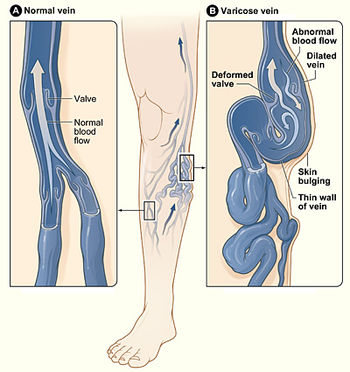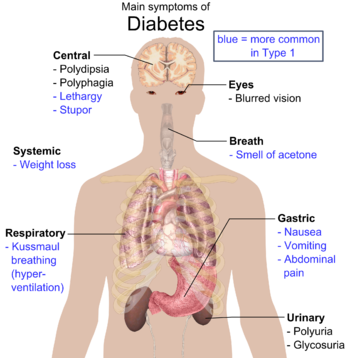 |
| Simplified diagram of the human Circulatory system in anterior view. Français : Diagramme simplifié du système circulatoire humain en vue antérieure (en Anglais). (Photo credit: Wikipedia) |
By Alan Knight
Your
body’s circulatory system is responsible for sending blood, oxygen, and
nutrients throughout the body. When
blood flow to a specific area of the body is reduced, you may experience the
symptoms of poor circulation. Poor
circulation is most common in your extremities, such as your legs and arms. Poor
circulation isn’t a condition in itself, but a result of other health issues.
Several
conditions can lead to poor circulation.
The most common causes include obesity, diabetes, heart conditions, and
arterial issues. Let’s look at this
further.
Peripheral
artery disease (PAD) can lead to poor circulation in your legs. PAD is a circulatory condition that causes
narrowing of the blood vessels and arteries.
In an associated condition call atherosclerosis, arteries stiffen due to
plaque buildup in the arteries and blood vessels. Both conditions decrease blood flow to your
extremities and can result in pain.
Over
time, reduced blood flow in your extremities can cause numbness, tingling,
nerve damage, and eventually tissue damage.
Eventually, if left untreated, reduced blood flow and plaque in your
carotid arteries may result in a stroke.
If plaque buildup takes place in the arteries in your heart, you run the
risk of having a heart attack.
 |
| English: The illustration shows how a varicose vein forms in a leg. Figure A shows a normal vein with a working valve and normal blood flow. Figure B shows a varicose vein with a deformed valve, abnormal blood flow, and thin, stretched walls. The middle image shows where varicose veins might appear in a leg. (Photo credit: Wikipedia) |
Blood
clots partially or entirely block the flow of blood. They can develop almost anywhere in your
body, but a blood clot that develops in your arms or legs can lead to
circulation problems.
Blood
clots can develop for a variety of reasons, and they can be dangerous. If a blood clot in your leg breaks away, it
can pass through other parts of your body including your heart and lungs. When this happens, the results may be
serious, even deadly.
Varicose
veins are enlarged veins caused by incompetent venous valves. The veins appear gnarled and engorged, and
they are most often found on the back of the legs. The damaged veins cannot move blood as
efficiently as other blood vessels, so poor circulation may become a
problem. Although rare, varicose veins
can also cause blood clots.
Your
genes largely determine whether or not you’ll develop varicose veins. If a relative has varicose veins, your risk
is higher.
Diabetes
can cause problems in many areas of your body.
Poor circulation caused by diabetes can cause leg cramping, and more
specifically cramping in your calves.
This cramping may be especially bad when you’re physically active. People with advanced diabetes may have a
difficult time detecting the signs of poor circulation because diabetic
neuropathy can cause reduced sensation in your extremities.
 |
| English: Overview of the most significant possible symptoms of diabetes. See Wikipedia:Diabetes#Signs_and_symptoms for references. Model: Mikael Häggström. To discuss image, please see Template talk:Häggström diagrams (Photo credit: Wikipedia) |
Diabetes
can cause heart and blood vessel problems, and people with diabetes are at an
increased risk for atherosclerosis, high blood pressure, and heart disease.
Obesity
puts a burden on your body. Plus, if
you’re overweight, sitting or standing for hours may lead to additional
circulation problems. Obesity
also puts you at an increased risk for many of the other causes of poor
circulation, including varicose veins and blood vessel problems.
People
who experience chronically cold hands and feet may have a condition called
Raynaud’s disease. This disease causes
the small arteries in your hands and toes to narrow. Narrowed arteries are less capable of moving
blood through your body, so you may begin experiencing symptoms of poor
circulation. The symptoms of Raynaud’s
disease are particularly prevalent when you’re in cold temperatures or
experiencing an unusual level of stress.
Let’s
look at some commonsense home remedies that can help deal with poor
circulation. Make sure, first and
foremost, that if you are suffering from circulatory disorders you consult your
doctor.
 |
| Courtesy of |
- Walk for a minimum of 30 minutes, at least 5 times a week.
- Enjoy swimming, jogging, biking, trekking and similar activities, a few times a week.
- Do simple foot and hand exercises for 15 minutes daily in the morning
You don’t have to over-exert yourself with exercise. You shouldn’t overly stress your body if your circulation is poor.
Regular
massage can help move blood through the congested areas. A relaxing massage of the whole body helps
dilate the blood vessels, which in turn facilitates blood flow.
Testimonial on the therapeutic benefits of a TubKing Walk in tub.
Hydrotherapy
is another simple and effective way to improve blood circulation. It helps dilate the blood vessels and thus
promotes blood flow. The newly
introduced Walk In Tub offers a convenient and compact device with multiple
hydrotherapy features. It allows the
person to walk into the tub by way of a watertight door. They can then sit on the ADA compliant seat
and fill the tub with warm water. Most
Walk in Tubs stand about 40 inches high with a seat that is 17 inches from the
floor. The person can simply recline and
enjoy the benefits of soaking in warm water to help relax the body.
But there is more. These tubs typically come with two
systems. Air jets send warm air into the
water to create thousands of therapeutic bubbles. This stimulates the skins and helps with
circulation. There is also a control for
introducing water jets. This feature
will more vigorously massage the body and stimulate circulation. The jets are adjustable and can direct the
water to any part of the body. Directing
the jets toward the feet can work wonders.
These tubs also come safety features, such as the low entry threshold,
to guard against falling, and the slip resistant floor and seat. A convenient interior grab bar and easy-reach
controls makes it a perfect safety tub.
 |
| Courtesy of TubKing.com |
Poor
circulation is no laughing matter. Talk
to your medical professional and try the simple suggestions above for a happier
and healthier life.
 In this article, I have discussed how to improve poor blood circulation
through various methods including exercise, various therapies’ and the use of a
Walk in Tub. I detail how these various
methods can improve your quality of life, so that living with poor blood circulation
can become easier.
In this article, I have discussed how to improve poor blood circulation
through various methods including exercise, various therapies’ and the use of a
Walk in Tub. I detail how these various
methods can improve your quality of life, so that living with poor blood circulation
can become easier.
Would you like to receive a FREE COPY of our new e-book? Tub
King's Ultimate Guide to Cast Iron/Porcelain Tubs, Walk-in Tubs & Safety
Suite Showers. Fill in the form below and we will send it to you
for free! It is also for sale and you can see/buy it on
Amazon.com by clicking on this link.
Have a question? Feel
free to contact me at the number or email listed at the end of this article and
I will personally get back to you. It’s been my pleasure sharing this
information with you.
Alan Knight is the owner of Tub King, Inc., and SeniorBathtub.com in Jacksonville, Florida. He has many years of experience in the antique and senior bathtub industries. In addition to providing superior products, Tub King has been honored with “Best of Jacksonville Chamber Awards” for four years running. If you would like to contact Alan Knight, call (800) 409-3375 or (800) 843-4231; or send an email to alan@tubking.com.
Related articles











No comments:
Post a Comment